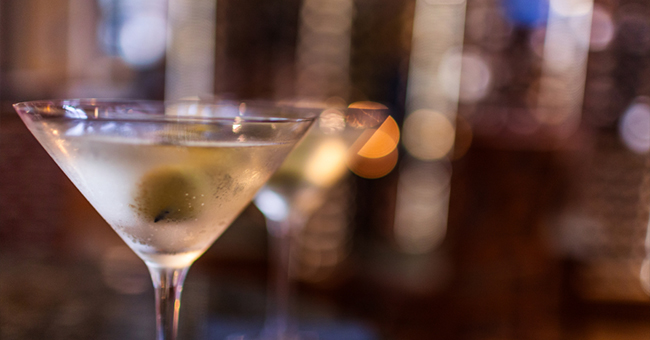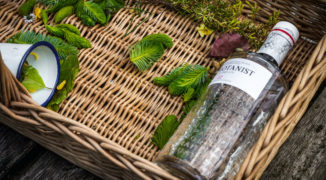The martini is ubiquitous, yet no two are ever the same. It’s simple on the surface, but offers infinite variations. It’s a classic drink, yet it has changed over time, and there are numerous ways to elevate it further.
“This is a drink that looks on paper that it’s an incredibly simple drink,” says Claire Smith-Warner, head of spirit creation and mixology at Belvedere Vodka. “But you start to uncover all the possible permutations, all the variables … and we did the math, and came up with this crazy number.”
Factoring in a choice of gin or vodka, different brands, assorted vermouths, shaking or stirring, ratios of the spirit to the vermouth, type of garnish, among other variables, Belvedere pegged that number at 9.6 quadrillion variations of the martini. So, not infinite — but pretty damn close.
“I think one of the reasons that people are sort of intimidated by the drink is that it comes with this folklore, this mysticism, that it’s this iconic drink that you can’t mess with,” says Smith-Warner. “But all of these different possible ways that you can enjoy it makes this drink one of the most personable drinks that there is.”
The evolution of the martini
Even those who adhere to a highly rigid definition of what does or does not constitute a martini today —’prescriptivists’ in Smith-Warner’s lingo — would have to admit that the drink has changed incredibly since its introduction.
“It’s important to remember that if you want to be more historical about it, the gin people drank then was much more like the Old Tom gin that we drink now … martinis had sweet vermouth, or Italian vermouth, and Old Tom gin, which together is kind of like a Negroni without the Campari,” says Jeffery Dillion of Manhattan’s Bathtub Gin. “I’ve made it and people are like ‘wow, that’s great, what’s this?’ And I’m like that’s a martini! That’s the original idea of what a martini is.”
A far cry from what most people would expect, it reflects changes in preferences, changes in available ingredients and their qualities, and a hard-earned, natural progression and refinement.
“The drink is a creature of evolution,” says Smith-Warner. “It reflects fashions and our preferences and the way that our palate has changed … That’s why it’s so versatile.”
Dillion ticks off a progression from sweet martinis, to gradually-increasing drier martinis, with both dry vermouth and dry gin, and also decreasing amounts of vermouth. “As [dry martinis] became dominant people wanted even drier martinis, and now you have a cold glass of vodka,” he says. “And, you can argue whether that’s ‘right’ or not but at the end of the day if somebody wants a stirred glass of vodka … If that’s what they want, that’s cool.”
While some might scoff at the vodka martini, it’s clearly well established in today’s drinking culture. “For me, again, the drink has evolved, and the vodka martini is as relevant to a drinker as a gin martini,” says Smith-Warner. “It’s about what you like to drink.”
Elevating the martini
Vodka or gin, shaken or stirred, dry or wet, olive or citrus, these are all choices to make. Regardless of what gets chosen, though, there are ways to elevate the end result.
At the bar, consider the right experience and presentation. For instance, at Bathtub Gin, Dillion offers a tableside service with pre-batched martinis mixed at the bar and served in a glass decanter on ice. “The martini service allows us to give somebody kind of a personalized, sharable cocktail in a platform which doesn’t require anybody to break the bank,” he says.
“People can drink at their own pace, they don’t have to keep stopping and ordering more cocktails,” says Dillion.”And it gets people drinking more martinis I think, which is a really positive thing, so I’m really proud of that one.”
While their tableside martini can be customized, on the menu it has a specific recipe. “It’s NOLET’s Silver and Carpano Dry Vermouth,” he says. “Now, we’ve always had Dolin Dry Vermouth … and as we were going through and workshopping the martini, I found I liked the Carpano better, it’s got a drier finish and works better with that gin.”
There Dillion touches on another all-important point, pairing the right type of spirit with the right type of vermouth. He generally prefers to pair a more floral gin with a drier vermouth to balance it out.
Dillion also offers a tableside service for the ultra-premium NOLET’s Reserve. This small batch offering includes botanicals such as lemon verbena and saffron. “It’s an incredibly floral gin, super delicious,” he says. With a retail price tag of $699, consumers are more likely to try a taste at the bar as opposed to nabbing a whole bottle. Therefore, at Bathtub, guests can order one ounce or two ounce pours, served on the rocks. While Dillion hasn’t had a guest request it in a martini, it only seems logical to chill that premium sipping gin with ice, but then take the next step and serve it up, as a dry all-gin martini.
The tableside martini is no new creation though, and that brings us to a certain Mr. James Bond. On the other side of the pond, visit Dukes Bar in London, said to be the muse for Ian Fleming’s martini adoration and Bond’s preference for “shaken, not stirred.” Here, a booze and garnish lined trolley is rolled out to guests, and the drink is mixed tableside on the spot.
London’s Connaught Bar also offers tableside martinis via their Martini Trolley service. They offer several gins and vodkas, but only utilize Gancia Dry vermouth, an exclusive to their bar, and a range of house-made bitters made from extracts such as lavender, coriander and ginger. But you won’t be ordering like Bond at the Connaught, where they insist on stirring their martinis.
Regardless of which ingredients you choose and how they’re presented, “Martinis really come down to the quality of the ingredients you’re using,” says Dillion.
But there are key techniques that make a martini great even if you can’t afford top shelf spirits.
“… The drink has to be cold, no matter what you use,” Smith-Warner says. “Everything you use must be cold. Your glass. Your vermouth should be chilled. Your vodka or gin should be from the fridge or even from the freezer. Get [the ingredients] to the right temperature, and that will do a lot of the work for you.”
Next is the technique of actually making the drink. “When you’re stirring a martini, very often you tend to not stir it long enough,” she says. “Really, a good stir should be about a minute depending on the quality of your ice to get it down to the right level of dilution and temperature. Shaking will do that in five to 10 seconds.”
Personalizing the martini
One of the best ways to elevate the martini is actually to personalize it, and to ensure that consumers understand what their choices are, how each choice affects the final drink, and ultimately, what they most enjoy.
Belvedere became the official drink of Bond prior to the release of “Spectre,” and Bond’s penchant for enjoying his martinis in a very particular way became a teaching point for the brand rather than a problem.
“We went into that collaboration very much with the opinion that we respect Bond’s choice, and we’re trying to encourage the consumer to have a preference, like Bond, and Bond’s preference is that he likes it shaken, not stirred,” says Smith-Warner.
“Proper” bar technique may insist on stirring, but “proper” should always get put to bed in favor of preference. “We just kind of broke it down, what does shaking do, what does stirring do, without prejudice,” says Smith-Warner. “We didn’t say one was better than the other, we just looked at the texture differences between the two, the temperature differences.”
High-quality ingredients, made at the right temperature and with the right technique. Beyond that, there’s no “right” way, and the “best” way for any two different individuals may be widely divergent.
“I think the main thing is don’t be intimidated by the drink. It’s actually much more forgiving than you think it is,” says Smith-Warner. “Experiment with that. And get a bartender who maybe can talk you through what their favorite martini is. Everyone has their own martini story.”
So how does Smith-Warner, who is seemingly qualified to lead a doctorate course on martinis, drink hers? “Gosh, it really depends,” she says, laughing.
“One of the biggest revelations for me throughout all this process is that I actually do like a shaken martini, and I like it wet. But, a wetter martini when shaken, the vermouth is much more obvious, so when I have a stirred martini I have it wet, when I have a shaken martini I have it dry. And I prefer a grapefruit twist, rather than a lemon twist, I think it’s a nicer citrus for a martini.”
Just one person’s personal preference. Find yours — or help others find theirs.





